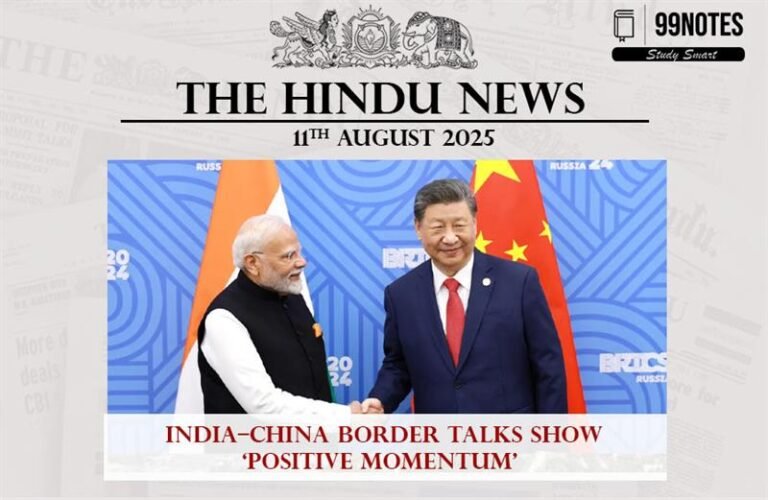24 June 2023 : The Hindu Editorial
The Hindu Editorial
24-June-2023
Daily Current Affairs For UPSC ,The Hindu Editorial Summary
1. Bridging the gap: On India and Gender Gap Report.
Topic: GS1, GS3 – Gender equality
Context:
-
-
-
India has climbed eight places in the Gender Gap Report 2023 and is ranked 127 out of 146 countries in terms of gender parity.
-
-
India and Gender Gap Report 2023:
According to the India’s ranking on various parametres of gender gap report 2023 – we can conclude following aspects:
-
-
-
India needs improvement in economic participation and opportunity, educational attainment, health and survival, and political empowerment to bridge the gender gap.
-
The country has made progress in education and political empowerment, with over 40% representation of women in local governance.
-
However, women represent only 15.1% of parliamentarians, indicating the need for the Women’s Reservation Bill, which proposes to reserve 33% of seats in the Lok Sabha and State Legislative Assemblies for women.
-
India ranks poorly in economic participation and opportunity, with less than 40% gender parity, highlighting the need for equal access and representation in senior and technical roles.
-
Health and survival indicators need improvement, although there has been progress in the sex ratio at birth.
-
Ensuring girls’ access to education and job opportunities is crucial for overall development, including nutrition, and breaking the cycle of early marriage and poor maternal and child health.
-
The COVID-19 pandemic has disproportionately affected women, with decreased labor participation rates and safety concerns.
-
Progress towards gender equality has been hindered by patriarchal and cultural norms, as well as safety issues.
-
-
More about Gender Gap Report 2023:
The Gender Gap Report is an annual publication by the World Economic Forum (WEF) that measures gender-based disparities and evaluates progress towards gender equality in various countries around the world. Here are some key points about the Gender Gap Report:
-
-
-
The report assesses gender gaps across four key areas: economic participation and opportunity, educational attainment, health and survival, and political empowerment.
-
It provides a comprehensive analysis of gender disparities and ranks countries based on their progress in closing the gender gap.
-
The Gender Gap Index is a key component of the report, which assigns scores to countries based on their performance in closing the gender gap.
-
The index measures gender parity on a scale of 0 to 1, with a score of 1 indicating complete gender equality.
-
The report highlights both the progress made and the challenges remaining in achieving gender equality across different countries and regions.
-
It provides insights into the gender gaps that exist in areas such as education, employment, leadership roles, health outcomes, and political representation.
-
The Gender Gap Report aims to raise awareness about gender disparities, stimulate dialogue, and encourage action to promote gender equality worldwide.
-
It serves as a valuable tool for policymakers, organizations, and advocates working towards gender equality by identifying areas that require attention and improvement.
-
-
Key findings of Gender Gap Report 2023 with respect to India:
-
-
-
India’s overall ranking improved from 135th in 2022 to 127th in 2023. This is a significant improvement, but India still has a long way to go to achieve gender parity.
-
The largest gender gap in India is in the Political Empowerment subindex, where India scored only 22.1%. This means that women are significantly underrepresented in positions of power in India.
-
The Economic Participation and Opportunity subindex also scored poorly for India, at 63.1%. This means that women are still underrepresented in the workforce and earn less than men for doing the same work.
-
The Educational Attainment subindex scored better for India, at 85.2%. This means that women and girls in India have access to education, but there are still some gaps in terms of enrollment and completion rates.
-
The Health and Survival subindex scored the best for India, at 95.9%. This means that women and girls in India have similar life expectancies and access to healthcare as men and boys.
-
-
The Gender Gap Report 2023 provides valuable insights into the state of gender equality in India. The report highlights the areas where India has made progress, as well as the areas where more work needs to be done. The report also provides recommendations for how to close the gender gap in India.
2. Squaring the circle at the India-Egypt summit
Topic: GS2 – International relations.
Context:
-
-
-
Prime Minister Narendra Modi’s visit to Egypt is significant despite potentially appearing underwhelming compared to his recent visit to the United States.
-
India-Egypt ties have a long historical connection, dating back to around 2750 BCE when the Pharaoh Sahure sent ships to the “Land of Punt,” believed to be peninsular India.
-
-
Historical link and important data related to India – Egypt relations:
-
-
-
The historic inspiration between India and Egypt needs to be invoked to enhance bilateral relevance and substance in their relationship.
-
In the 2022-23 fiscal year, India’s trade with Egypt amounted to $6,061 million, experiencing a 17% decline from the previous year, with a significant portion being petroleum-related.
-
Egypt ranks as India’s 38th largest trading partner, while India is Egypt’s sixth largest.
-
Indian investments in Egypt are spread across 50 projects totaling $3.15 billion, with a single company contributing half of the sum. In contrast, Egypt has invested only $37 million in India.
-
The number of Indians residing in Egypt is less than 5,000, with approximately a fifth of them being students.
-
-
Opportunities for India – Egypt relations:
-
-
-
Potential for increasing bilateral trade: Egypt is a large country with a population of 105 million and a robust economy worth $378 billion, offering potential for bilateral cooperation with India.
-
Egypt’s major imports, such as refined petroleum, wheat (largest importer globally), cars, corn, and pharmaceuticals, present opportunities for India to supply these goods.
-
Infrastructure support: Egypt has an ambitious infrastructure development agenda, including mega projects like the construction of New Cairo ($58 billion), a nuclear power plant ($25 billion), and a high-speed rail network ($23 billion), which can be areas of collaboration for India.
-
Tourism and cultural exchange: Promoting tourism and cultural exchange can further strengthen people-to-people contacts and deepen mutual understanding. Initiatives such as promoting Bollywood films in Egypt, organizing cultural festivals, and facilitating tourist exchanges can attract more visitors and boost the tourism industry in both countries.
-
Defense cooperation: Both India and Egypt have strong defense capabilities and face common security challenges. There is potential for defense collaboration, including joint exercises, defense equipment procurement, and sharing of best practices in counter-terrorism and maritime security.
-
Education and skill development: India can offer scholarships and training programs for Egyptian students, while Egypt can provide opportunities for Indian students to study Arabic language and culture. Exchange programs, academic partnerships, and joint research initiatives can promote knowledge-sharing and academic excellence.
-
Energy cooperation: India’s expertise in renewable energy and Egypt’s renewable energy potential can pave the way for collaboration in the energy sector. Joint projects in solar energy, wind energy, and hydroelectric power can contribute to clean and sustainable energy generation.
-
Strategic partnerships: India and Egypt can strengthen their strategic partnerships by actively engaging in regional forums such as the African Union and the Arab League. By aligning their interests and coordinating their positions on regional and global issues, both countries can enhance their influence and contribute to regional stability and development.
-
-
Challenges for India – Egypt relations:
-
-
-
Limited bilateral trade: Despite historical ties and institutional mechanisms, bilateral trade between India and Egypt remains relatively low. In 2022-23, trade declined by 17% compared to the previous year. The trade relationship lacks diversification and heavily relies on petroleum-related products.
-
Trade imbalance: India is Egypt’s sixth largest trading partner, while Egypt ranks as India’s 38th. There is a need for India to explore avenues for increasing exports and reducing the trade deficit.
-
Limited investments: Indian investments in Egypt are spread across 50 projects with a total value of $3.15 billion, but a significant portion of this amount comes from a single company. On the other hand, Egypt’s investments in India are relatively low, standing at $37 million. Encouraging greater investment flows and diversification in both directions is crucial.
-
Inefficacy of institutional mechanisms: While there are several bilateral institutional mechanisms in place, their effectiveness and purposefulness have been questioned. Merely rearranging bureaucratic structures without yielding tangible outcomes can hinder the progress of bilateral relations.
-
Economic challenges in Egypt: Egypt is grappling with a serious economic crisis, including a stagnant economy, high inflation rates (above 30%), currency devaluation, and scarcity of foreign exchange. These challenges pose obstacles to expanding economic cooperation and trade between the two countries.
-
Governance issues and reforms: Egypt’s economic reforms face obstacles due to entrenched interests and crony capitalism.
-
Reluctance of Gulf Arab states: The Gulf Arab states, which previously supported the Egyptian economy, have become more hesitant due to governance concerns. Their reduced support affects Egypt’s economic stability and could impact potential collaborations with India.
-
-
3. Warm welcome: On the Narendra Modi U.S. state visit and bilateral ties.
Topic: GS2 – International relations.
Context:
-
-
-
U.S. President Joe Biden referred to the India-U.S. partnership as one of the defining relationships of the 21st century during Prime Minister Narendra Modi’s state visit to Washington.
-
Various outcomes of Prime Minister’s visit to USA highlights ever-growing relations between India and USA.
-
-
Highlights of Prime Minister’s visit to USA:
-
-
-
Meeting with President Joe Biden: Modi met with President Biden in the Oval Office on June 23rd. The two leaders discussed a wide range of issues, including the COVID-19 pandemic, the economy, climate change, and security. They also announced a number of new initiatives, such as a $10 billion investment in clean energy and a new joint working group on technology.
-
Meeting with CEOs of US companies: PM met with CEOs of several US companies, including Microsoft, Google, and Amazon. The CEOs discussed ways to expand their businesses in India and to collaborate with Indian companies.
-
Address to the US Congress: PM addressed a joint session of the US Congress on June 22nd. In his speech, he outlined India’s economic and social progress, and he called for closer cooperation between India and the US. He also spoke about the importance of democracy and human rights.
-
The visit resulted in new deals in defense cooperation, semiconductor industry investments, and partnerships in quantum computing, advanced computing, and AI.
-
The co-production deal for jet engines in India involves a significant level of technology transfer.
-
India’s participation in the mineral security partnership and cooperation on critical and emerging technologies, particularly in clean energy, will strengthen future collaboration.
-
India’s involvement in space exploration through the Artemis Accords and NASA-ISRO partnerships will enhance its co-operation in the space sector.
-
-
-
-
-
Areas of disagreement, such as policies toward Russia’s actions in Ukraine and China, were set aside during the visit.
-
Concerns over democracy and human rights in India were raised by some members of the U.S. Congress, but were not a major focus of the visit.
-
Prime Minister Modi addressed concerns over minority rights and dissent during a press availability with President Biden, stating that human values and humanity are essential for democracy.
-
-
For Enquiry

24 June 2023 : The Hindu Editorial

24 June 2023 : Daily Current Affairs

23 June 2023 : Daily Quiz

23 June 2023 : Indian Express

23 June 2023 : PIB

23 June 2023 : The Hindu Editorial

23 June 2023 : Daily Current Affairs

22 June 2023 : Daily Quiz

21 June 2023 : Daily Quiz

22 June 2023 : Indian Express
The Hindu 24 June 2023 : The Hindu Editorial The Hindu Editorial
23-June-2023
Daily Current Affairs For UPSC ,The Hindu Editorial Summary
Facebook-f
Twitter
Youtube
1….
Daily Current Affairs 24 June 2023 : Daily Current Affairs DAILY CURRENT AFFAIRS
24-June-2023
Daily Current Affairs For UPSC ,Daily Current affairs of The hIndu…
Daily Quiz 23 June 2023 : Daily Quiz 23 June 2023 : Daily Quiz…
Indian Express 23 June 2023 : Indian Express Indian Express
23-June-2023
The Indian Express, CSE candidates can stay informed about current events…
PIB 23 June 2023 : PIB PRESS INFORMATION BUREAU
23-June-2023
Daily Current Affairs For UPSC ,The PIB ( Press Information Bureau…
The Hindu 23 June 2023 : The Hindu Editorial The Hindu Editorial
23-June-2023
Daily Current Affairs For UPSC ,The Hindu Editorial Summary
Facebook-f
Twitter
Youtube…
Daily Current Affairs 23 June 2023 : Daily Current Affairs DAILY CURRENT AFFAIRS
23-June-2023
Daily Current Affairs For UPSC ,Daily Current affairs of The hIndu…
Daily Quiz 22 June 2023 : Daily Quiz 22 June 2023 : Daily Quiz…
Daily Quiz 21 June 2023 : Daily Quiz 21 June 2023 : Daily Quiz…
Indian Express 22 June 2023 : Indian Express Indian Express
22-June-2023
The Indian Express, CSE candidates can stay informed about current events…





